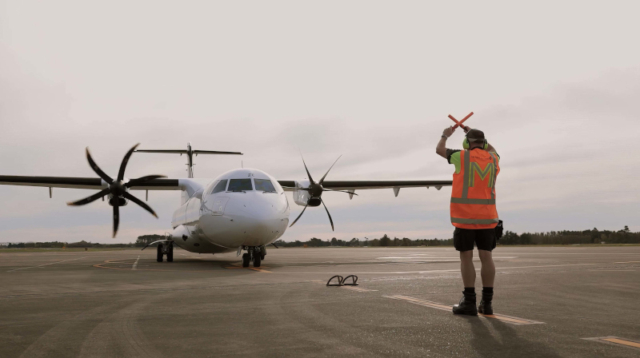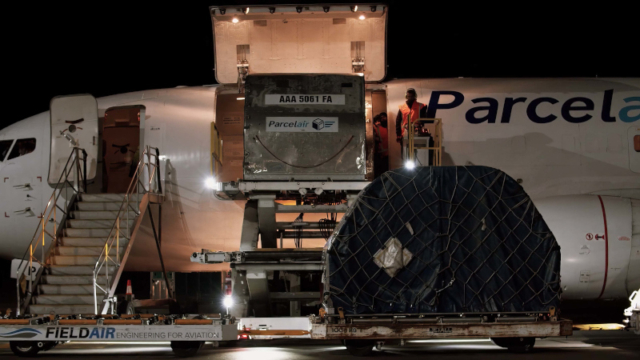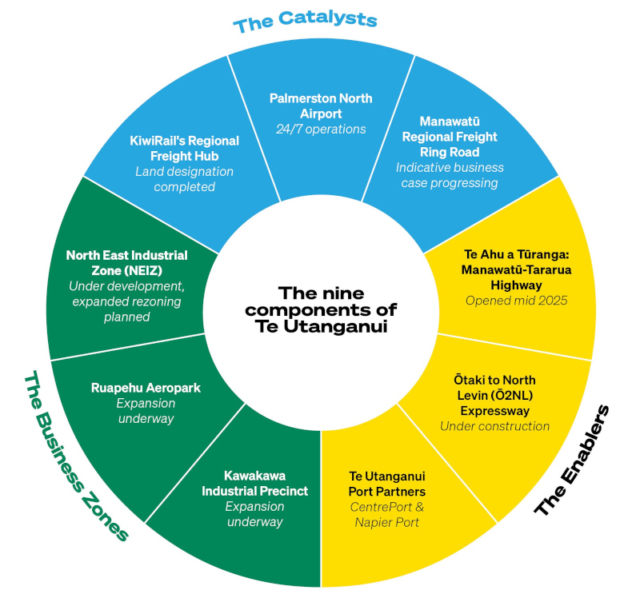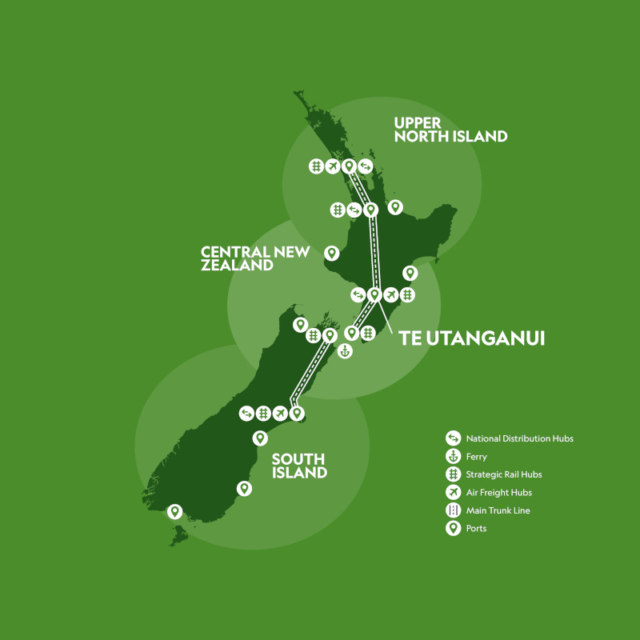Te Utanganui: A plan in action

Te Utanganui is set to grow even further with infrastructure projects like KiwiRail’s planned Regional Freight Hub, Palmerston North Airport’s expansion, and the Manawatū Regional Freight Ring Road. Photos: Central Economic Development Agency
In 2020, Manawatū based Central Economic Development Agency (CEDA) launched a bold initiative to establish a nationally significant logistics cluster in the heart of the country. The aim: to develop a high-performing, intermodal freight and distribution hub that would boost productivity, strengthen resilience, and unlock the region’s potential.
The concept was driven by the rapid growth of the region’s distribution and logistics sector, alongside mounting pressure on the national supply chain. It was a timely opportunity to position central New Zealand as a key logistics hub, designed to meet national demand while fuelling regional growth.
Fast forward to 2025, and Te Utanganui – the Central New Zealand Distribution Hub, has taken its place as one of the three critical key nodes in the national freight network, complementing the Golden Triangle in the North and Canterbury in the South. Today, Te Utanganui is a thriving cluster of coordinated investments, public-private partnerships, and national infrastructure that is shaping New Zealand’s economic future.

CEDA has led the development of Te Utanganui as part of its core mandate to drive sustainable economic growth in the Manawatū region. With a focus on unlocking potential, attracting investment, and strengthening infrastructure, CEDA recognised the opportunity to position Manawatū at the centre of the national freight network. By bringing together local and central government, iwi, industry, and infrastructure partners, CEDA has played a pivotal role in delivering a hub of regional and national significance.
A region rallying together for national impact
From the beginning, Te Utanganui has been a showcase in collaborative development. The original strategy was developed in close partnership with central government, local councils, iwi, economic development agencies, business networks, and major investors. This cluster of central North Island stakeholders and agencies spans 22 territorial authorities and four regional councils across the lower North Island, representing a region united behind a shared economic vision.
This North Island collective contributes over 22.4 per cent of New Zealand’s GDP, second only to Auckland, and Te Utanganui is perfectly positioned in the centre of this economic powerhouse.
Strategically located, nationally significant
What sets Te Utanganui apart is its geographic advantage and multimodal capability. Located in Palmerston North, the hub is the only place in Aotearoa where road, rail and air freight modes converge side-by-side, unlocking seamless logistics efficiency. With strong strategic ties to Napier and Wellington ports, Te Utanganui acts as a linchpin connecting domestic and international markets. Based in Manawatū, Te Utanganui builds on the region’s connectivity, agility, and strategic foresight which have made it a powerful engine for Aotearoa’s growth.
It is already a critical servicing point for the central New Zealand regions, including Taranaki, Manawatū-Whanganui, Hawke’s Bay, Wairarapa, and Wellington, and hosts one of only three 24/7 national air freight terminals. This interconnectivity provides the resilience, optionality, and future scalability with New Zealand’s freight demand set to grow by 60 per cent over the next 30 years.
Coordinated investments driving growth
Strategic infrastructure investment across the Manawatū region is powering business growth and helping future-proof the economy. Major developments such as Te Ahu a Turanga – the Manawatū Tararua Highway, upgrades to Palmerston North Airport, and the planned KiwiRail Regional Freight Hub are already delivering significant benefits. Looking ahead, projects like the Manawatū Regional Freight Ring Road, recently listed in the national Infrastructure Priorities Programme will further enhance the efficiency and resilience of New Zealand’s national supply chain.
These initiatives are more than freight upgrades – they’re catalysts for innovation, investment, and job creation.

At the heart of this transformation is Te Utanganui – the Central New Zealand Distribution Hub. By integrating road, rail, and air freight infrastructure into a single intermodal precinct, Te Utanganui offers faster, more reliable connections to both domestic and international markets. This connectivity is a game-changer for key sectors such as agrifood, logistics, and advanced manufacturing – reducing supply chain costs and boosting export capability.
Already home to major operators like Toyota NZ, Woolworths, and Foodstuffs, Te Utanganui continues to attract a diverse range of new businesses, including Hiringa Energy, Australian Defence Apparel, and several third-party logistics providers. The momentum is growing – with interest ranging from international stakeholders and national corporates to individual investors seeking to tap into the strength of this high-performing cluster.
From its inception, Te Utanganui has exemplified collaborative development. The original strategy was co-designed by central government, local councils, iwi, economic development agencies, business networks, and major investors. This collective spans 22 territorial authorities and four regional councils across the lower North Island – a region aligned behind a shared vision for sustainable economic growth.
Together, this central North Island economy contributes over 22.4 per cent of New Zealand’s GDP – second only to Auckland – and Te Utanganui sits firmly at its centre.
Te Utanganui is not a single development, but a master-planned ecosystem of coordinated infrastructure, industrial precincts, and enabling public works. Together, these investments support a seamless and scalable logistics network.
Key projects include:
- KiwiRail’s planned Regional Freight Hub: Consolidating freight and shifting volumes from road to rail
- Palmerston North Airport’s $43 million cargo upgrade: Enhancing air freight capacity
- Expansion of the North East Industrial Zone: Premium land for logistics and manufacturing
- Expansion of the Kawakawa Industrial Precinct: Opening up many more acres of land ripe for development
- The Manawatū Regional Freight Ring Road: Ensuring efficient, safe, and uncongested freight movement
- Te Ahu a Turanga – Manawatū Tararua Highway: Creating faster east-west connections across the lower North Island
In total, more than $8 billion in public and private investment is committed or underway across the region this decade – a clear sign of confidence in the strength, scale, and strategic potential of Te Utanganui.
Anchoring a high-calibre cluster
Within Te Utanganui, three key business zones – Ruapehu Aeropark, North East Industrial Zone, and Kawakawa Industrial Precinct – form an interconnected hub supporting a diverse range of industries. These include third-party logistics providers, warehousing, distribution centres, manufacturing bases, and more.

Te Utanganui is already home to over 100 businesses, from established logistics leaders to fast-growing innovators. Recent additions include Woolworths New Zealand and Foodstuffs North Island, both investing in major new distribution centres. Other notable tenants choosing Te Utanganui as their New Zealand base include Australian Defence Apparel (ADA NZ), Hiringa Energy, Proliant, DKSH, Toyota New Zealand, and many others.
This concentration of logistics, transport, and supporting services is accelerating productivity, reducing delivery times, and creating new economies of scale. It also gives rise to a true cluster effect: businesses benefit from co-location, shared infrastructure, talent access, and innovation spillovers.
With scalable industrial land, strong utilities, and access to a growing labour force, Te Utanganui is also attracting innovation-focused businesses in renewable energy, agri-logistics, circular economy, and more.
Driving economic, environmental and social benefits
Te Utanganui is not just a logistics project, it’s a nation-building initiative delivering significant economic, environmental, and social benefits. By boosting national freight productivity, opening new export pathways, attracting investment, and creating skilled jobs, it supports a resilient and diversified regional economy. It also strengthens the resilience of New Zealand’s freight network, providing alternative routes and modes to keep communities and businesses connected when disasters or disruptions occur. Environmentally, it promotes a shift from road to rail, lowering emissions through sustainable design and greener freight movement. Socially, it builds workforce capability while enhancing safety and efficiency across the transport network, strengthening communities and businesses alike.
The environmental and social benefits are equally significant. Te Utanganui supports a shift from road to rail and promotes smarter, lower-emissions freight movement, aided by green infrastructure and sustainable design. Socially, the project is creating high-quality jobs across logistics, infrastructure, and related sectors, building long-term capability in the regional workforce. It is also enhancing safety and efficiency across the transport network, strengthening communities and businesses alike.
The opportunity ahead
The freight and logistics sector is facing massive change. Population growth, shifting consumer patterns, digital transformation, and climate goals are all reshaping the landscape. Te Utanganui is ready.
Whether you are an investor seeking long-term returns, a government agency looking to enable productive infrastructure, or a regional leader searching for a proven model of collaborative development – Te Utanganui is your case study in action.
It is a place where strategy meets delivery, and where the future of New Zealand’s freight network is already being built.

Robbie Woods
Robbie Woods is the Programme Director for Te Utanganui, spearheading the development of Central New Zealand’s multimodal logistics hub. With extensive experience in infrastructure delivery, Robbie holds an Honours Degree in Civil Engineering and has managed projects ranging from short-term assignments to large, complex, intergenerational programs, bringing a versatile and expert approach to every stage of development.